A Brief Book Summary from Books At a Glance
by Steve West
About the Author
Stephen J. Nichols is president of Reformation Bible College and chief academic officer and teaching fellow for Ligonier Ministries. He earned a PhD from Westminster Theological Seminary in Philadelphia and is the author of numerous books.
Introduction
This book examines the way that the person of Christ has been understood, presented, and shaped by various philosophical, theological, and cultural forces in the history of America. Nichols traces the development of Christology in America from the Puritans until the present day, analyzing and critiquing trends in both society and evangelicalism.
Table of Contents
Introduction
1 The Puritan Christ
2 Jesus for a New Republic
3 Gentle Jesus, Meek and Mild
4 Jesus, Hero for the Modern World
5 Jesus on Vinyl
6 Jesus on the Big Screen
7 Jesus on a Bracelet
8 Jesus on the Right Wing
Epilogue
Summary
Chapter 1: The Puritan Christ
The identity of Christ has been a major question throughout the ages, and it dominates the New Testament. The way that Christ is understood in America has been shaped by American thinkers and influences. Today when people look back at the Puritans in America, there is a lot of caricature and misunderstanding. The Christology of the Puritans is often presented as theologically precise but without much passion. An emphasis is placed on Christ’s deity and transcendence. They revered and worshiped him, but unlike present-day evangelicals, they did not depict Jesus as a kind of close, familiar friend. Puritans are often said to have focused more on propositional theology than personal experiences. This picture needs to be balanced. The Puritans did have an extremely high, creedal, orthodox Christology, but they also had inner piety.
Edward Taylor (1642-1729) was a minister and arguably America’s greatest colonial poet. Although this is not widely known, the Puritans were great supporters of the arts. Taylor’s poetry reveals a deep passion for bringing together theological orthodoxy with heartfelt piety. In his work, there is a devotional and theological love for Christ. Taylor preached and wrote about Christ from his head and his heart, acknowledging that no words could ever capture and convey Christ. Nevertheless, he did—as did many other Puritans—excel at using words to speak of religion. Taylor taught his congregation about the hypostatic union, and the matchless grace of the divine Son becoming a man. He did not merely teach about Jesus, he worshiped and delighted in Jesus, and wanted his people to do so with rich understanding and deep, emotional piety. . . .
[To continue reading this summary, please see below....]The remainder of this article is premium content. Become a member to continue reading.
Already have an account? Sign In
